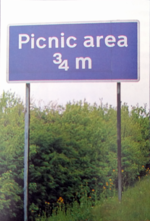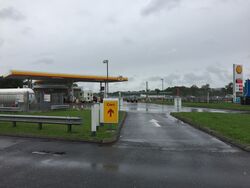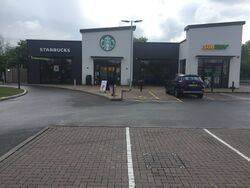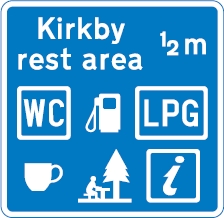Rest area
Many countries use the phrase rest area to describe what in Britain would be a service area.
On British motorways, a rest area is defined concept: it's like motorway service area, only it doesn't need to provide fuel or food. This page is about that specific type of facility.
In Ireland, a "rest area" is a motorway lay-by; their locations are publicised by TII and the RSA. The equivalent to the sort-of rest area described on this page is known in Ireland as a Type 2 Service Area, but none have been built.
Motorway rest areas remain very rare in the UK. Developers have shown almost no interest in the concept at all, and the only open rest areas are all quirks of history:
- Leeming Bar (A1(M))
- Scotch Corner (A1(M))
- Todhills (M6)
History
Motorway service areas in Britain are normally large developments, but there have been many attempts to build something much smaller.
Previous Attempts

In 1965, when the M6 was built through Cumberland and Westmorland, the local authorities suggested motorists might like to take advantage of the good views here by using parking areas provided every six miles. The Ministry of Transport preferred the idea of building services every 12 miles, not wanting the motorway network to be filled with leisure drivers. They also looked at building car parks at every motorway junction.
Similar arguments had been made for the M50 through Worcestershire, although that was before motorway services had been finalised as a concept. In the event, none of these ideas were taken forward.
In 1973, one government parliamentary secretary was impressed by French motorway picnic areas, and suggested the UK did the same. Newland Common was going to be the first candidate, but Brent Knoll was built instead. Maintenance problems and commercial demand caused it to be sold to different operators. The whole experience was later summarised as "unfavourable". Although it was known as Brent Knoll rest area, the road signs made it clear it was a "picnic area".
At Hapsford, no developer was interested in the site so in 1978 it opened as a council-run picnic area. This lasted until 1998, when private developers expanded it.
The final motorway example dates back to the opening of the M40. Problems planning the services caused the road to open with 'emergency facilities'; temporary facilities provided at junctions, taken away when the full services were ready.
On the A-road network, there are a handful of designated "picnic areas", which may have toilets and a refreshments kiosk. These are supposed to be treated as tourist attractions and called a "picnic area", but one on the A120 is signed as a "rest area". This is very similar to the motorway examples given above, and more were considered for A-roads in the 1970s, but these are just picnic areas and not what is meant by a "rest area" in the current regulations.
Current Version

In 2008 the A74 at Todhills was being upgraded to become a motorway. Strictly speaking, the small service area at Todhills should have closed, as it had limited facilities and there were existing alternatives nearby. Closing it would have meant an expensive compensation process and breaching assurances which had previously been given to the landowner.
At the same time (and the timing was almost-certainly no coincidence), the Department for Transport held a review of their policy on roadside facilities. This brought up the subject of rest areas and suggested they could be used to give drivers more places to stop. The idea was approved and 'motorway rest area' became an official status for smaller facilities that want to add to the existing offer - just in time for Todhills to become one.
In 2010, the Highways Agency published a list of the gaps between all the existing motorway facilities and compared them to the criteria set out in Circular 01/2008, in the hope that this would encourage more developers to come forward. In 2013, they relaxed their regulations which meant "having too many alternatives" would no longer be a reason to stop new service area. The 2022 policy barely mentions rest areas at all.
A Second And A Third
Todhills remained the country's only rest area until Leeming Bar joined it in 2014, soon followed by Scotch Corner. Both are survivors of the A1 which had been upgraded to a motorway, even though the former is a long distance from the nearest motorway junction and isn't clearly signed.
Strictly speaking, Scotch Corner doesn't meet the standards required of a rest area as it doesn't have HGV parking, but understandably a decision was made to let this slide and simply warn HGVs that they couldn't stop there. Other than this, all three of those offered significant facilities; enough to qualify as a full motorway service area and with more on offer than some existing motorway service areas have. Rest area status therefore appears to be being used with no apparent logic.
Things have changed a little since then: Leeming Bar has significantly scaled back its operation, partly as a result of COVID-19 travel restrictions. It was only able to do this because it had been providing more than a rest area had ever needed to. This is therefore another fluke of history, but does show one benefit of rest area status for operators.
The service areas on the A1(M) continue to keep planning departments up at night. Moto have now said they want to have both Scotch Corner and Leeming Bar changed from rest areas to service areas, but they seem to have suggested this can be done without making any changes to Leeming Bar. If this were to happen, it would again leave Todhills as the UK's only rest area, but it would also confirm that rest area status is meaningless and can just be changed on a whim.
The distinction became even more confused in March 2023, when National Highways threatened to downgrade Knutsford, which has been a motorway service area since 1963, to a fourth motorway rest area, citing its lack of HGV parking. The regulations say that both rest areas and service areas must provide parking for all types of vehicle, but the national highway authority seems to disagree.
Another Failed Project

In December 2019, there was a plan to open the new A14 in Cambridgeshire as a motorway, which would be called the A14(M). This would have taken in two existing service areas: Cambridge and Brampton Hut. The intention was to designate Cambridge as a full motorway service area while Brampton Hut, which has a series of separate restaurants that mostly close at night, would be classed as a rest area. That at least shows some logical thinking, even if it's still odd given that there are existing motorway service areas which only provide fuel at night.
Shortly before the road opened the motorway plan was abandoned and both Cambridge and Brampton Hut were signed as standard trunk road services using new, black-on-white signs, so the A14(M) example unfortunately only appears on internal emails.
As of 2022, nearly 15 years after rest area status was created, no developers have proposed building any rest areas themselves.
Requirements
As set out in Circular 01/2022, rest areas must provide at least the following facilities, 24 hours a day, every day of the year, while complying with all current and future equality legislation:
- Two hours free parking for all vehicle types
- Free toilets, baby-changing facilities and a Changing Places, with no need to make a purchase
- Access to a free-of-charge telephone for emergency use
- Free wifi
- Free power points available for device charging
- Access for those carrying out duties for and on behalf of the Secretary of State for Transport.
The number of parking spaces and toilets required is calculated using the same formula as that for service areas, except the figures should be halved, and rounded upwards if appropriate.
Road Signs

The signing for a rest area is structurally the same as that of a motorway service area, only with "services" substituted for "rest area". However, no branding of any kind is permitted on these signs, with only traditional symbols being allowed. This makes for a major visual difference and a big drawback for operators. Signage is also not allowed from more than a mile away.
These rest area signs were added to the Traffic Signs Regulations and General Directions in 2016. Until then, special authorisation was required.
The Brent Knoll experiment used white-on-brown signs with car, motorbike and picnic symbols.
Official standards don't allow for a rest area that isn't on a motorway. If highway authorities wanted to recognise one, they would just call it a lay-by or car park, and these are sometimes found in scenic areas.